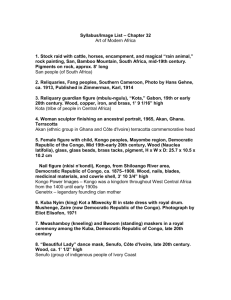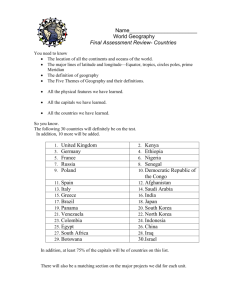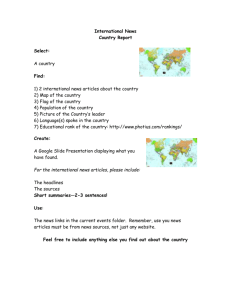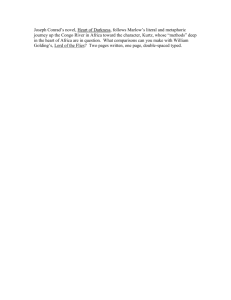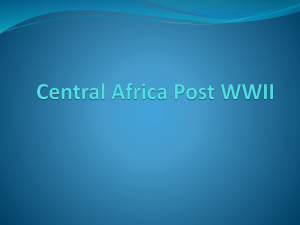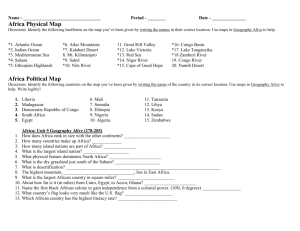DRC Presentation Talking Points
advertisement
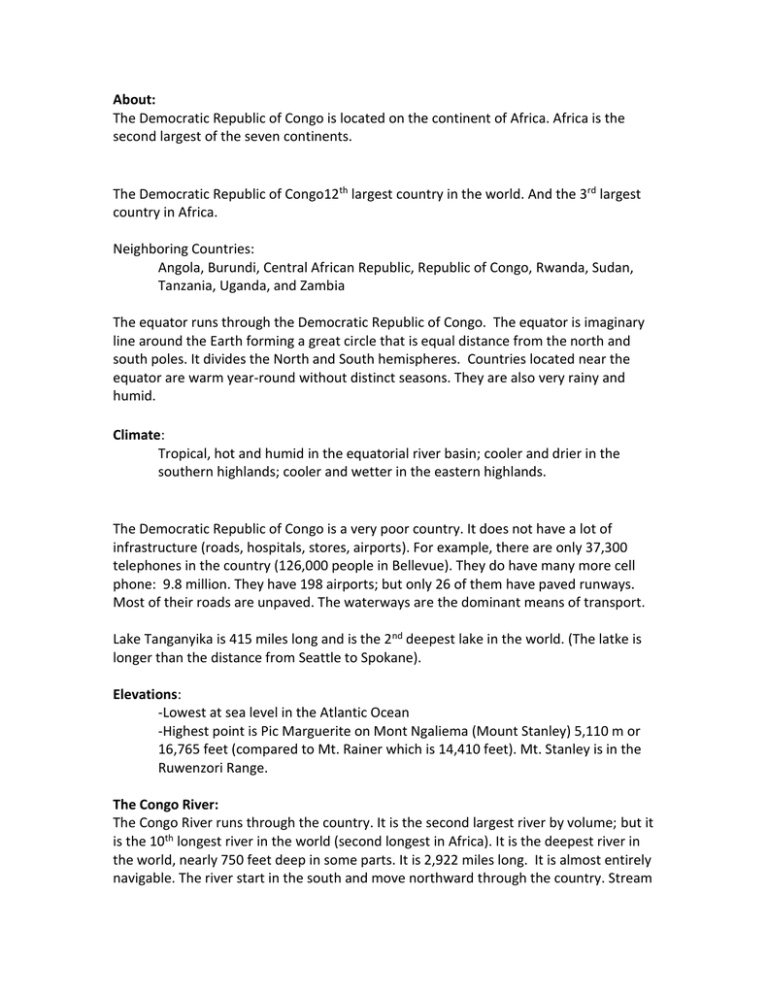
About: The Democratic Republic of Congo is located on the continent of Africa. Africa is the second largest of the seven continents. The Democratic Republic of Congo12th largest country in the world. And the 3rd largest country in Africa. Neighboring Countries: Angola, Burundi, Central African Republic, Republic of Congo, Rwanda, Sudan, Tanzania, Uganda, and Zambia The equator runs through the Democratic Republic of Congo. The equator is imaginary line around the Earth forming a great circle that is equal distance from the north and south poles. It divides the North and South hemispheres. Countries located near the equator are warm year-round without distinct seasons. They are also very rainy and humid. Climate: Tropical, hot and humid in the equatorial river basin; cooler and drier in the southern highlands; cooler and wetter in the eastern highlands. The Democratic Republic of Congo is a very poor country. It does not have a lot of infrastructure (roads, hospitals, stores, airports). For example, there are only 37,300 telephones in the country (126,000 people in Bellevue). They do have many more cell phone: 9.8 million. They have 198 airports; but only 26 of them have paved runways. Most of their roads are unpaved. The waterways are the dominant means of transport. Lake Tanganyika is 415 miles long and is the 2nd deepest lake in the world. (The latke is longer than the distance from Seattle to Spokane). Elevations: -Lowest at sea level in the Atlantic Ocean -Highest point is Pic Marguerite on Mont Ngaliema (Mount Stanley) 5,110 m or 16,765 feet (compared to Mt. Rainer which is 14,410 feet). Mt. Stanley is in the Ruwenzori Range. The Congo River: The Congo River runs through the country. It is the second largest river by volume; but it is the 10th longest river in the world (second longest in Africa). It is the deepest river in the world, nearly 750 feet deep in some parts. It is 2,922 miles long. It is almost entirely navigable. The river start in the south and move northward through the country. Stream flow out of the eastern highlands combine and make Lualaba River. West of Kisangani the river becomes the Congo. he Congo River basin is home to some of the largest undisturbed stands of tropical rainforest on the planet. In fact, the rain forest is second only to the Amazon in Brazil. Because of it equatorial locations, the DRC experiences large amounts of rain and has the highest frequency of thunderstorms in the world. In some places the annual rainfall is 80 inches. The history of the Democratic Republic of Congo has been marked by turmoil and war and that is one of the reasons it is so very poor and undeveloped. Also Known as: Congo Free State, Belgian Congo, Congo/Leopoldville, Congo/Kinshasa, Zaire In 1996 the First Congo War started and in 1998 the Second Congo War began. The Second Congo War is also called the African World War because it involved 8 African nations and killed 5.4 million people. The deadliest conflict since World War II. Even though peace accords were signed in 2003, there is still a lot of fighting going on in the country. It is a country that is rich in natural resources. Lots of minerals, water, oil. It is also most bio-diverse country in Africa. There are 7 National Parks in Democratic Republic of Congo. Some animals you might find in the National Parks in Democratic Republic of Congo include the Okapi, the forest elephant, hippopotami, and the white rhino. One of the most well-known and endangered animals in the Democratic Republic of Congo are the mountain gorillas. There are only about 700 mountain gorillas remaining on Earth and nearly half of them live in the forest of the Virunga National Park in central Africa. Due to wars, deforestation, slash and burn agriculture practices and hunting the parks and the animals in the DRC are threatened. Much of the environmetal damage is rotted in the Congo’s extreme poverty and history of conflict. The okapi is the national animal of Democratic Republic of Congo. Virunga is Africa's oldest national park. The Park has the greatest diversity of habitats within a single African park. It ranges from swamps and steppes, lava plains and savannas, dense lowland and higher bamboo forests to the snowfields of Ruwenzori, and the volcanoes of Virunga with a correspondingly very wide array of flora and fauna. The word 'Virunga' corresponds to the word ‘volcano’ in Kinyarawanda. The volcanic activity has given rise to diverse habitats with complex and varied ecosystems and an abundance of species. They have active volcanos in the Democratic Republic of Congo. Here are a couple of pictures of them. Two of the most active African volcanoes are located in the Democratic Republic of Congo. They are Nyamuragira (shield volcano) and Nyiragongo (stratovolcano or composite volcano). This is a photo of the Nyiragongo volcano. A volcano is an opening in the Earth’s surface (crust), which allows hot magma, ash, and gases escape from below the surface. They are typically found where tectonic plates either come together (converge) or are moving apart (diverge). Shield volcanoes are named for their broad shield-like profile. The lave flows a great distance from the vents; but generally these types don’t explode catastrophically. Composite volcanoes the type we think of when we think about the word volcano. They are made up of layers (strata) of ash, cinders and lava. These are the type of volcanoes that are most dangerous when they explode. Volcanoes are classified not just by shape; but by the frequency of eruptions. Those that erupt regularly are called active, those that have erupted in historical times are called dormant and those that have not erupted in historical times are called extinct. For our activity: I have a coloring sheet of the flag of the Democratic Republic of Congo. This flag was adopted in 2006 and represents the hopes for a change in a country that has had a long troubled history. The sky blue field divided diagonally from the lower hoist corner to upper fly corner by a red stripe bordered by two narrow yellow stripes; a yellow, five-pointed star appears in the upper hoist corner. The blue represents peace and hope, red the blood of the country's martyrs, and yellow the country's wealth and prosperity; the star symbolizes unity and the brilliant future for the country. Languages: French (official), Lingala (a lingua franca trade language), K ingwana (a dialect of K iswahili or Swahili), K ikongo, Tshiluba; however more than 700 local languages and dialects are spoken.
